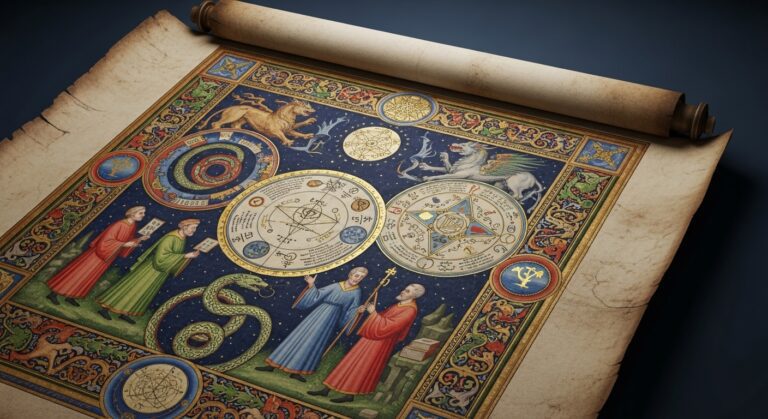The Gnostic Gospels: Hidden Christian Texts That Challenge Traditional Beliefs

Lost Christian Scriptures: The Gnostic Gospels and Their Forbidden Teachings – Imagine encountering ancient texts that could shake the foundation of Christian beliefs as you know them.
The Gnostic Gospels, discovered in 1945, offer just that—hidden narratives that present Jesus and salvation in a way that contrasts with orthodox teachings.
These writings propose a spiritual journey focused on personal knowledge and inner enlightenment. With their complex cosmology and mystical elements, they invite you to explore a world of alternative Christian doctrines that challenge traditional views.
Key Takeaways
Hide- The Gnostic Gospels emphasize personal spiritual knowledge (gnosis) as essential for salvation, challenging traditional Christian salvation views.
- They introduce the Demiurge concept, a flawed creator god, contrasting with orthodox Christian views of a perfect creator.
- Gnostic texts present Mary Magdalene as a key disciple, challenging traditional gender roles and her portrayal in orthodox Christianity.
- The Gnostic Gospels use symbolism and esoteric interpretations to explore divine mysteries, differing from literal scriptural interpretations.
- Early Church councils excluded Gnostic writings due to theological conflicts, aiming to maintain orthodox unity and authority.
What Are the Gnostic Gospels and Why Were They Hidden?
You might be surprised to learn that the discovery of the Gnostic Gospels, a collection of ancient texts found in 1945 at Nag Hammadi, revolutionized biblical scholarship by challenging traditional narratives.
These texts, which include writings not found in the New Testament, offer insights into Gnosticism—a belief system that emphasizes personal spiritual knowledge over orthodox teachings.
Understanding why these gospels were hidden involves exploring the tension between early Christian orthodoxy and alternative theological perspectives that threatened established doctrines.
The Discovery That Changed Biblical Scholarship Forever
When you consider the discovery of the Nag Hammadi Library, you’re looking at a pivotal moment in biblical scholarship, as 13 leather-bound codices surfaced in Egypt.
These texts offered new perspectives on early Christianity. Dating evidence suggests these manuscripts originated between the 2nd and 4th centuries CE, providing essential context for understanding diverse theological viewpoints of that era.
This cache of texts was hidden away, likely due to their controversial content, which challenged orthodox beliefs and offered alternative interpretations of Christian doctrine.
The Nag Hammadi Library: 13 Leather-Bound Codices Found in Egypt
Though hidden beneath the sands of Egypt for centuries, the discovery of the Nag Hammadi Library in 1945 revolutionized biblical scholarship and our understanding of early Christian texts.
You can appreciate how ancient leather bindings and precise leather tanning techniques contributed to Egyptian artifact preservation.
Through manuscript exterior analysis, scholars unravel the codex manufacturing process, offering insights into these 13 leather-bound codices‘ enduring legacy and protection.
Dating the Manuscripts: Evidence from the 2nd to 4th Centuries CE
While examining the origins of the Nag Hammadi texts, dating the manuscripts to the 2nd to 4th centuries CE is crucial for understanding their historical context and significance. You’ll rely on medieval manuscript preservation insights, linguistic analysis techniques, paleographic dating methods, and material composition studies.
Artifact provenance research ensures accurate timelines, offering a secure basis for exploring the theological shifts and cultural dynamics of early Christianity.
Understanding Gnosticism and Its Core Beliefs
When exploring Gnosticism, you’ll find that its core beliefs center on knowledge as the path to salvation, contrasting sharply with traditional religious doctrines.
The Gnostic view introduces the concept of the Demiurge, a lesser god responsible for creating the material world, which they often perceive as flawed or corrupt.
This belief system, emphasizing inner enlightenment and a distinct cosmology, likely contributed to the Gnostic Gospels being hidden and excluded from orthodox teachings.
Knowledge as Salvation: The Gnostic Path to Divine Truth
As you explore the intriguing world of the Gnostic Gospels, it becomes clear that knowledge serves as the cornerstone of salvation in Gnostic belief systems. Gnostics prioritize mystical enlightenment, seeking spiritual awakening through secret teachings and esoteric knowledge.
This pursuit of divine consciousness offers safety and certainty, guiding adherents toward a transformative understanding of existence, ultimately leading to the path of salvation and divine truth.
The Demiurge Concept: A Different View of Creation and God
The Gnostic Gospels present a fascinating perspective on creation and the nature of the divine through the concept of the Demiurge.
As a Demiurge creator, this flawed deity embodies cosmic ignorance, crafting a world of material deception.
You may find this notion unsettling, as it suggests divine ignorance within creation itself.
However, it offers a unique lens through which to understand traditional beliefs and spiritual safety.
The Gospel of Thomas: Jesus’s Secret Sayings Collection
When you explore the Gospel of Thomas, you encounter 114 sayings attributed to Jesus that present alternative Christian teachings.
These sayings emphasize discovering the Kingdom of Heaven within oneself, aligning with a Gnostic interpretation of salvation.
This perspective challenges conventional views, inviting you to contemplate a more introspective path to spiritual enlightenment.
114 Sayings That Offer Alternative Christian Teachings
When you examine the Gospel of Thomas, you’ll notice its emphasis on mystical wisdom and hidden meanings in Christ’s words, offering a distinct perspective on his teachings.
By comparing Thomas with the Canonical Gospels, you can identify variations in themes and messages that highlight alternative Christian teachings.
This analysis encourages a deeper understanding of early Christian diversity and the different ways followers interpreted Jesus’s message.
Mystical Wisdom and Hidden Meanings in Christ’s Words
While mainstream Christian teachings focus on the canonical gospels, the Gospel of Thomas presents an intriguing collection of sayings attributed to Jesus that challenge conventional interpretations.
You’ll find symbolic language and divine wisdom interwoven with hidden meanings, offering mystical interpretations through spiritual allegories.
These sayings provide alternative insights into Christ’s teachings, encouraging you to explore deeper layers of understanding within your spiritual journey, while seeking comfort in their profound messages.
Comparing Thomas with the Canonical Gospels
The Gospel of Thomas, with its collection of 114 sayings attributed to Jesus, presents an intriguing counterpoint to the canonical gospels. It invites readers to explore a different facet of Christian teachings.
You’ll find Thomas’s sayings emphasize personal enlightenment over narrative structures.
While Gospel similarities exist, canonical differences are evident.
This teachings comparison reveals alternative perspectives, challenging traditional interpretations while maintaining a focus on spiritual growth and safety.
The Kingdom of Heaven Within: Gnostic Interpretation of Salvation
In the Gospel of Thomas, you’re encouraged to seek self-knowledge as a direct path to connecting with the divine, suggesting that salvation comes from within rather than external rituals.
This perspective also emphasizes women’s spiritual equality, highlighting early Gnostic thought’s progressive stance on gender.
Self-Knowledge as the Path to Divine Connection
Delving into the Gospel of Thomas, you discover an intriguing emphasis on self-knowledge as an essential path to divine connection. Inner reflection becomes the cornerstone for spiritual awakening, guiding you toward your divine self.
This journey fosters consciousness expansion, revealing mystical insights that illuminate your path. Embrace this introspective process, ensuring a safe, grounded approach to nurturing a profound bond with the divine.
Women’s Spiritual Equality in Early Gnostic Thought
While examining the early Gnostic texts, you’ll notice a fascinating aspect of women’s roles in spiritual contexts, particularly highlighted in the Gospel of Thomas. These writings emphasize female leadership and spiritual empowerment, offering a reinterpretation of biblical narratives.
The Gospel of Mary Magdalene: A Female Apostle’s Perspective
In examining the Gospel of Mary Magdalene, you explore her role as Jesus’s closest disciple and teacher, highlighting a unique perspective within early Christianity.
This gospel challenges traditional narratives by positioning Mary as a central figure, leading to tensions with Peter that reveal underlying gender dynamics.
Mary Magdalene as Jesus’s Closest Disciple and Teacher
In exploring the Gnostic texts, you’ll find that they portray Mary Magdalene as having a unique and intimate relationship with Jesus, highlighting her as a pivotal figure among his disciples.
These texts, particularly the Gospel of Mary, emphasize visions and revelations that were exclusively communicated to her, suggesting a profound spiritual authority.
Such narratives challenge traditional perceptions and invite you to reconsider the role of female apostles in early Christian communities.
Her Special Relationship with Christ According to Gnostic Texts
Exploring the Gnostic texts, particularly the Gospel of Mary Magdalene, reveals a profound reinterpretation of Mary Magdalene’s role as a key figure in early Christian teachings.
You discover her personal divine connection with Christ, emphasizing spiritual intimacy and sacred union.
These texts highlight unique revelations, positioning her as a vessel of divine femininity, challenging traditional narratives and offering a fresh perspective on her spiritual significance.
Visions and Revelations Exclusive to Mary’s Gospel
Mary Magdalene’s unique insights and revelations, as presented in her gospel, reshape our understanding of her role among Jesus’s disciples. Her text highlights:
- Mary’s visions: Offering sacred insights into the divine domain.
- Divine revelations: Providing spiritual messages that challenge traditional beliefs.
- Mystical encounters: Illustrating her profound connection with Jesus.
These elements collectively emphasize her significance as a trusted disciple and teacher, offering safety in spiritual exploration.
The Conflict Between Peter and Mary: Gender Dynamics in Early Christianity
In the Gospel of Mary Magdalene, you’ll find a portrayal of a significant conflict between Peter and Mary that reflects the gender dynamics within early Christianity. This text highlights the resistance male apostles had towards acknowledging female spiritual authority.
It challenges the traditional church hierarchy that often excluded women. By presenting Mary as a legitimate spiritual leader, it questions established norms and invites a reevaluation of gender roles within the early Christian community.
Male Apostles’ Resistance to Female Spiritual Authority
Though often overlooked in traditional Christian narratives, the Gospel of Mary Magdalene provides a compelling insight into the early gender dynamics within the burgeoning Christian community. You can observe:
- Resistance: Male apostles challenged female clergy, questioning their spiritual leadership.
- Hierarchy: Gender hierarchy was evident as male leaders resisted changes to church authority.
- Equality: The text advocates for gender equality, clashing with established norms.
How This Text Challenges Traditional Church Hierarchy
Why does the Gospel of Mary Magdalene stand out as a radical text challenging the traditional church hierarchy? It presents Mary as a spiritual leader, unsettling the church authority by suggesting a divine hierarchy inclusive of women.
This perspective questions ecclesiastical power and doctrinal control held by male apostles, highlighting gender dynamics in early Christianity. It advocates for more inclusive spiritual leadership and shared ecclesiastical responsibilities.
The Gospel of Philip: Marriage, Sexuality, and Sacred Mysteries
In the Gospel of Philip, you’ll encounter the concept of the Sacrament of the Bridal Chamber, a Gnostic marriage ritual that offers profound insights into early Christian views on union and spirituality.
This text uses symbolic language to convey hidden meanings about marriage and sexuality, suggesting a mystical connection between human relationships and divine mysteries.
The Sacrament of the Bridal Chamber: Gnostic Marriage Ritual
In examining the Gospel of Philip, you encounter the notion of a spiritual union between Christ and Mary Magdalene, which symbolizes the sacred marriage central to Gnostic beliefs. This union isn’t merely symbolic but serves as a profound example of sacred sexuality’s role in achieving Gnostic salvation.
Spiritual Union Between Christ and Mary Magdalene
How does the Gospel of Philip depict the spiritual union between Christ and Mary Magdalene? It presents this connection as a profound divine union achieved through:
- Meditative practice: Encouraging spiritual awakening and heightened awareness.
- Mystic symbolism: Utilizing sacred rituals to convey deeper truths.
- Spiritual awakening: Facilitating a transformative experience that transcends physical reality.
This union emphasizes a harmonious bond, highlighting a unique spiritual connection beyond traditional narratives.
Sacred Sexuality and Its Role in Gnostic Salvation
The Gospel of Philip explores not only the spiritual connection between Christ and Mary Magdalene but extends this theme to the broader context of sacred sexuality. You’ll find that sexual symbolism represents divine union, highlighting sacred mysteries that transcend physical boundaries.
This spiritual intimacy fosters gender equality, offering a safe space where both partners equally participate in Gnostic salvation through the sacrament of the bridal chamber.
Symbolic Language and Hidden Meanings Throughout the Text
When you examine the Gospel of Philip, you’ll notice its use of symbolic language and hidden meanings, particularly in its allegorical interpretations of biblical stories.
The text suggests that these stories convey deeper truths about spiritual realities, prompting readers to question traditional understandings.
Additionally, Philip’s portrayal of resurrection challenges conventional views, presenting it as a transformative inner experience rather than a physical event.
Allegorical Interpretations of Biblical Stories
Although often dismissed by mainstream Christian thought, the allegorical interpretations found in the Gospel of Philip reveal a lively mosaic of symbolic language that challenges traditional readings of biblical narratives. You’ll encounter:
- Symbolic Allegories: Examine how marriage and sexuality are depicted as spiritual symbolism.
- Metaphorical Narratives: Uncover mystical allegories.
- Hidden Meanings: Explore layers beneath literal interpretations.
The True Nature of Resurrection According to Philip
Delving into the Gospel of Philip, you encounter a profound reinterpretation of resurrection that diverges considerably from traditional Christian doctrine.
Here, resurrection is seen as a spiritual rebirth through divine mysticism, emphasizing esoteric teachings.
This text suggests resurrection symbolism isn’t about physical revival but an awakening to eternal life.
It offers a safe path to understanding resurrection as an inner transformation, aligning with Gnostic ideals.
The Apocryphon of John: A Radically Different Creation Story
In exploring “The Apocryphon of John,” you’ll encounter a creation story that contrasts with traditional Christian narratives. This text reveals a secret revelation given to John the Apostle, highlighting the distinction between the true God and the Demiurge within Gnostic cosmology.
The Secret Revelation Given to John the Apostle
In examining the Apocryphon of John, you encounter a creation narrative that challenges traditional views by introducing the concept of a false god responsible for the world’s creation.
This text presents Sophia’s fall as a pivotal event leading to the material universe‘s birth, suggesting a cosmic misstep rather than divine intention.
As you explore these themes, consider how they reshape the understanding of divinity and the material world’s origins within Gnostic thought.
How the World Was Created by a False God
The Apocryphon of John presents a creation narrative that starkly contrasts with traditional Judeo-Christian accounts, positing that the material world was fashioned by a false god. This creation myth suggests:
- Divine deception: The false god’s acts create a spiritual illusion, misleading humanity.
- Cosmic illusion: The perceived reality isn’t true reality.
- Safety in awareness: Understanding this narrative can offer spiritual insight and protection.
Sophia’s Fall and the Birth of the Material Universe
While exploring the Gnostic texts, one encounters the intriguing tale of Sophia’s fall, which marks a pivotal moment in the Apocryphon of John. In this narrative, the Fall of Wisdom, or Divine Sophia, initiates the creation of the material universe.
This Gnostic cosmology reveals Sophia’s myth as a profound commentary on creation, illustrating a radical departure from traditional beliefs and emphasizing the complexity of divine interactions.
The True God Versus the Demiurge: Gnostic Cosmology Explained
In the Gnostic cosmology outlined in the Apocryphon of John, you’ll find a complex hierarchy of divine beings that contrasts starkly with traditional monotheistic views.
This narrative describes a supreme, unknowable God, distinct from the Demiurge—a lesser deity responsible for the flawed material world.
Humanity’s essence, according to this belief, contains a divine spark trapped within physical bodies, highlighting the tension between spiritual enlightenment and material existence.
Multiple Levels of Divine Beings and Spiritual Hierarchy
Ever wondered how Gnostic cosmology interprets the universe’s structure? It presents a complex cosmic order where divine hierarchy prevails.
You explore multiple spiritual domains inhabited by hierarchical angels and angelic beings. Here’s a breakdown:
- Divine Hierarchy: A structured order of spiritual authority.
- Angelic Beings: Guardians of various spiritual realms.
- Cosmic Order: The universe’s layered organization ensuring balance and safety.
Humanity’s Divine Spark Trapped in Material Bodies
Exploring the vast tapestry of Gnostic cosmology, you encounter the notion that every human possesses a divine spark, a fragment of the true God trapped within material bodies. This concept suggests potential for soul awakening through spiritual enlightenment.
Why the Early Church Rejected These Gospels
When exploring why the early Church rejected the Gnostic Gospels, you should consider the significant role of the Council of Nicaea in establishing the biblical canon. This council aimed to unify Christian doctrine, leading to conflicts between Gnostic beliefs and the emerging orthodoxy.
The theological differences, particularly regarding the nature of Jesus and salvation, made it difficult for Gnostic texts to align with the orthodox Christian narrative.
The Council of Nicaea and the Formation of Biblical Canon
You might consider how the Council of Nicaea, convened under Emperor Constantine, played a pivotal role in shaping the biblical canon by prioritizing certain texts that aligned with the emerging orthodoxy.
The political and religious factors at play led to the exclusion of the Gnostic Gospels, as they conflicted with the unified Christian doctrine that Constantine sought to establish.
This effort to standardize Christian teachings was essential in consolidating the Church’s authority and maintaining religious cohesion across the empire.
Political and Religious Factors in Scripture Selection
As the early Church sought to establish a unified doctrine, the selection of canonical scriptures was heavily influenced by both political and religious factors. You must consider:
- Religious influence: Dominant theological views shaped the canon, sidelining divergent texts.
- Political interference: Leaders aimed to consolidate power, leading to authority conflicts.
- Text censorship: Certain writings were excluded to prevent division, ensuring a cohesive belief system.
Emperor Constantine’s Role in Standardizing Christian Doctrine
The early Church’s endeavor to establish a unified doctrine wasn’t only a matter of theological debate but also a complex interplay of ecclesiastical and imperial power.
Emperor Constantine’s role was pivotal, akin to technological innovation today, as he wielded authority to convene the Council of Nicaea.
Theological Conflicts Between Gnostic and Orthodox Christianity
You’re about to explore the theological conflicts that set Gnostic Christianity apart from its Orthodox counterpart, focusing on differing views on salvation, scripture, and church authority. These differences weren’t just academic; they’d real-world implications, contributing to the persecution of Gnostic communities and their texts.
Understanding these conflicts helps explain why the early church ultimately rejected the Gnostic Gospels.
Different Views on Salvation, Scripture, and Church Authority
While exploring the reasons behind the early church’s rejection of the Gnostic Gospels, it’s important to contemplate the stark theological conflicts between Gnostic and Orthodox Christianity.
You’ll find that:
- Salvation through works: Gnostics emphasized inner enlightenment over traditional rituals.
- Scripture as allegory: Gnostics viewed biblical texts symbolically.
- Church authority debates: They questioned established hierarchies, preferring personal faith over church-led rituals.
The Persecution of Gnostic Communities and Their Texts
Examining the theological conflicts between Gnostic and Orthodox Christianity reveals a deeper layer of contention that contributed to the early church’s rejection and persecution of Gnostic communities and their texts.
Gnostic persecution arose from early Christian conflicts over divergent beliefs. As a secret community, Gnostics faced text suppression and religious censorship, ensuring that their doctrines remained marginalized and their influence on mainstream Christianity minimized for safety.
Archaeological Evidence and Modern Discoveries
You can explore the impact of the Nag Hammadi discovery, where local peasants unearthed a collection of lost manuscripts. This discovery profoundly expanded scholars’ understanding of early Christian texts.
Carbon dating and manuscript analysis techniques have dated these texts to the 3rd and 4th centuries. This provides insight into the diversity of early Christian thought.
These discoveries challenge traditional narratives and open discussions about the variety of beliefs that existed alongside orthodox Christianity.
The Nag Hammadi Discovery: Peasants, Scholars, and Lost Manuscripts
You might find it intriguing that the pivotal discovery of the Nag Hammadi manuscripts began with an accidental find by a farmer named Muhammad Ali in 1945.
This serendipitous event set off a complex journey of these texts from the Egyptian desert to esteemed international museums, highlighting the intricate interplay between local peasants and global scholars.
Such discoveries underscore the significant impact of chance on the preservation and dissemination of ancient knowledge.
Muhammad Ali’s Accidental Find in 1945
Although chance often plays a role in historical discoveries, Muhammad Ali’s accidental find in 1945 stands out as a pivotal moment in religious archaeology. This event revealed the Nag Hammadi texts, which encompass:
- Ancient manuscript preservation techniques, ensuring these documents’ survival.
- Gnostic art symbolism that offers insight into religious ritual practices.
- Manuscript translation challenges linked to early Christian architecture and its intricate history.
The Journey from Egyptian Desert to International Museums
When the Nag Hammadi texts emerged from the sands of Egypt, they began a transformative journey that would bridge ancient and modern worlds. These manuscripts shifted from the ancient desert to museum exhibitions, becoming symbols of cultural exchange.
Archaeological excavation revealed their significance, while preservation techniques guaranteed their safety. Now, they reside in international museums, guaranteeing these lost manuscripts educate future generations safely and effectively.
Carbon Dating and Manuscript Analysis Techniques
When examining the Gnostic Gospels, you rely on carbon dating and manuscript analysis to authenticate these ancient texts.
These scientific methods provide a timeline for when the manuscripts were likely created, despite the challenges posed by papyrus preservation and translation.
Scientific Methods Used to Authenticate Ancient Texts
In the quest to authenticate ancient texts like the Gnostic Gospels, scientific methods such as carbon dating and manuscript analysis play a crucial role.
You can rely on these methods to guarantee safety and accuracy:
- Radiocarbon Dating: Determines the age of materials.
- Ink Analysis: Assesses the composition and age of writing inks.
- Paleography Techniques: Provides insights into historical handwriting styles.
Papyrus Preservation and Translation Challenges
Preserving and translating ancient texts like the Gnostic Gospels present significant challenges, especially given the fragile nature of papyrus. You must consider papyrus degradation and ancient ink composition, which complicate paleographic analysis.
Translation nuances arise from the need to accurately interpret these texts. Employing advanced preservation techniques guarantees these valuable documents remain intact, allowing safe study and deepening understanding of their historical context.
Key Differences Between Gnostic and Traditional Christianity
When examining the key differences between Gnostic and traditional Christianity, you notice contrasting views on salvation and the role of Jesus.
Gnosticism emphasizes salvation through esoteric knowledge, while traditional Christianity stresses faith and grace.
Additionally, Gnostics see Jesus primarily as a teacher of hidden truths, whereas traditional Christians view Him as the Savior who redeems humanity.
Salvation Through Knowledge Versus Faith and Grace
When examining the differences between Gnostic and traditional Christianity, you notice that Gnosticism emphasizes salvation through secret wisdom, contrasting with the latter’s focus on faith and grace.
Gnostic teachings often prioritize individual enlightenment, suggesting that personal spiritual knowledge is key to salvation.
In contrast, traditional Christianity typically values communal worship and collective faith, emphasizing the importance of grace and shared religious practices.
The Role of Secret Wisdom in Gnostic Spiritual Practice
While traditional Christianity emphasizes salvation through faith and grace, Gnostic spiritual practice places a significant focus on the pursuit of secret wisdom or gnosis as the path to salvation.
You’ll encounter:
- Mystical illumination: Revealing divine knowledge through personal insight.
- Secret teachings: Engaging with hidden symbolism to gain deeper understanding.
- Spiritual awakening: Achieving enlightenment through inner exploration and revelation.
These elements guide your journey toward spiritual fulfillment.
Individual Enlightenment Versus Communal Worship
Although both Gnostic and traditional Christian practices aim for spiritual fulfillment, they diverge substantially in their approaches to enlightenment and salvation.
Gnosticism emphasizes personal growth through spiritual solitude, encouraging meditation practices and inner reflection to achieve individual empowerment.
In contrast, traditional Christianity focuses on communal worship, seeking salvation through shared faith and grace.
This distinction influences the path you choose for spiritual development and safety.
Jesus as Teacher Versus Jesus as Savior
When examining Gnostic and traditional Christian views, you’ll notice contrasting interpretations of Christ’s nature and mission.
Gnostics often emphasize Jesus as a spiritual teacher who imparts secret knowledge, whereas traditional Christianity focuses on Jesus as the savior who redeems humanity through sacrifice.
This distinction highlights the importance Gnostics place on personal spiritual experience over doctrinal adherence.
Different Interpretations of Christ’s Nature and Mission
In exploring the divergent interpretations of Christ’s nature and mission, one finds a profound distinction between Gnostic and traditional Christian perspectives. Gnostic Christology emphasizes:
- Christ’s dual nature – a blend of human and divine elements rather than the singular divine incarnation.
- Mission of salvation – viewed as a path to enlightenment rather than redemption from sin.
- Nature of the Son – seen as a spiritual guide, not solely a savior.
The Importance of Personal Spiritual Experience
How does personal spiritual experience shape one’s understanding of Jesus in Gnostic and traditional Christianity?
In Gnosticism, personal reflection and mystical insights lead you on an inner journey, fostering a spiritual awakening and a divine connection with Jesus as a teacher.
Conversely, traditional Christianity emphasizes Jesus as a savior, prioritizing collective belief over individual experience, offering a more secure, shared path to salvation.
The Influence of Gnostic Ideas on Modern Spirituality
You can observe how Gnostic ideas have resurfaced in modern spirituality, particularly influencing New Age movements that emphasize personal spiritual knowledge over institutionalized doctrines.
This revival not only reflects in spiritual practices but also in literature and art, where Gnostic themes inspire narratives of inner enlightenment and the quest for hidden truths.
New Age Movements and Gnostic Revival
You’re likely to notice how modern spiritual practices, especially within New Age movements, reflect a renewed interest in alternative Christian perspectives.
This shift is particularly evident in feminist theology, where there’s a strong emphasis on revisiting and reevaluating figures like Mary Magdalene.
Such explorations often challenge traditional narratives, offering fresh interpretations that resonate with contemporary spiritual seekers.
Contemporary Interest in Alternative Christian Perspectives
In recent years, there’s been a notable surge in interest towards alternative Christian perspectives, particularly those influenced by Gnostic ideas. You might notice this in:
- Modern Christian denominations embracing Gnostic ideals.
- Ecumenical dialogues promoting interfaith perspectives.
- Religious art influences reflecting cultural adaptations.
These shifts indicate a growing openness to spiritual exploration, offering a sense of safety in diverse theological understandings.
Feminist Theology and the Rediscovery of Mary Magdalene
While traditional narratives have often marginalized Mary Magdalene’s role, feminist theology has propelled her to the forefront of theological discourse, influenced profoundly by Gnostic ideas.
A feminist reinterpretation emphasizes spiritual equality and acknowledges female discipleship, challenging entrenched gender dynamics.
Literary and Artistic Inspirations from Gnostic Texts
You’ll notice how Gnostic texts have profoundly influenced both popular culture and academic discourse, as seen in works like Dan Brown’s “The Da Vinci Code”. This novel, along with others, not only captivates audiences but also stirs interest in Gnostic ideas, prompting deeper exploration and study.
Meanwhile, scholars continue to assess these texts, offering varied interpretations that further enrich the dialogue between ancient spirituality and modern thought.
Dan Brown’s “The Da Vinci Code” and Popular Culture
Although Dan Brown’s “The Da Vinci Code” sparked widespread intrigue in Gnostic texts, its portrayal of these ancient writings particularly impacted popular culture by inviting readers to question established religious narratives.
You observe three main effects:
- Gnostic influence: Highlighting hidden truths.
- Popular misconceptions: Blurring fact and fiction.
- Modern adaptations: Inspiring new cultural symbolism.
These elements reflect both the allure and risks of fictional portrayals.
Academic Research and Scholarly Interpretations
Dan Brown’s fictional narrative has unquestionably stirred public interest, but the academic exploration of Gnostic texts offers a more nuanced understanding of their impact on modern spirituality. Scholars focus on ancient manuscript preservation and employ textual analysis methods to uncover insights.
Translation challenges and historical context fuel scholarly debate, providing a safe space to explore how these texts influence contemporary spiritual and artistic expressions.
Reading the Gnostic Gospels Today: Translations and Resources
When you explore the Gnostic Gospels today, selecting the best modern translations can substantially enhance your understanding, especially those tailored for general readers.
Access to digital archives and online study materials also provides a wealth of information, allowing you to analyze texts with greater ease and context.
These resources collectively support a more thorough and accessible engagement with Gnostic writings in contemporary settings.
Best Modern Translations for General Readers
When choosing the best modern translations of the Gnostic Gospels for general readers, you’ll encounter various scholarly approaches that prioritize different aspects of the text, such as linguistic accuracy or interpretative clarity.
It’s important to weigh these approaches in context, as they can substantially impact your understanding of the content and its nuances.
For advanced students, accessing the original Coptic text provides a deeper insight into the authentic language and structure, offering a more enriched perspective.
Comparing Different Scholarly Approaches to Translation
Although the Gnostic Gospels present a complex tapestry of early Christian thought, translating them presents a unique set of challenges that scholars have approached in various ways. You’ll notice these key considerations:
- Translation accuracy: Ensuring the text remains true to its original meaning.
- Interpretative methodologies: Strategies differ based on linguistic nuances.
- Cultural context: Understanding background influences scholarly debates.
Accessing Original Coptic Text for Advanced Students
Advanced students looking to access the original Coptic text of the Gnostic Gospels face a unique opportunity to deepen their understanding of early Christian writings.
By engaging with the Coptic language, you’ll explore manuscript preservation and translation techniques that reveal textual variants.
Utilize scholarly resources to guarantee a safe, accurate analysis, helping you navigate the complexities of these ancient texts with confidence and precision.
Digital Archives and Online Study Materials
You can explore high-resolution manuscript images of the Gnostic Gospels through various digital archives, which provide an unprecedented level of access to these ancient texts. These online resources allow you to examine the fine details of the manuscripts without the need for physical travel or handling fragile documents.
High-Resolution Manuscript Images Available Online
Access to high-resolution images of the Gnostic Gospels has revolutionized the study of these ancient texts, providing unprecedented opportunities for scholars and enthusiasts alike.
You can now:
- Examine manuscript illumination, enhancing your understanding of artistic elements.
- Utilize digital preservation to combat papyrus deterioration, ensuring lasting accessibility.
- Analyze ancient handwriting and scholarly annotations, offering insights into historical contexts and interpretations.
These resources make studying the Gnostic Gospels safer and more insightful.
Wrapping Up
As you explore the Gnostic Gospels, you uncover a fascinating tapestry of early Christian thought that challenges traditional beliefs.
These texts invite you to question the nature of spiritual authority and explore the truth of a more personalized, mystical faith.
By examining these alternative narratives, you gain insights into how diverse early Christian doctrines were and how they continue to influence modern spirituality. Ultimately, you’re encouraged to reconsider the complexities of faith and belief.
- Ehrman, B. D. (2003). Lost Christianities: The battles for scripture and the faiths we never knew. Oxford University Press.
- King, K. L. (2003). The Gospel of Mary of Magdala: Jesus and the first woman apostle. Polebridge Press.
- Lambert, M. (2013). Gnosticism: A guide for the perplexed. Bloomsbury T&T Clark.
- Layton, B. (Trans.). (1987). The Gnostic scriptures. Doubleday.
- Meyer, M. (Trans.). (2003). The Gospel of Thomas: The hidden sayings of Jesus. HarperSanFrancisco.
- Pagels, E. (1979). The Gnostic gospels. Random House. (books.google.com, en.wikipedia.org)
- Peterson, E. (2007). Mary Magdalene: Beyond the myth. Eerdmans.
- Robinson, J. M. (Ed.). (1988). The Nag Hammadi library in English. Harper & Row.
- Riddle, J. M. (2006). Apocryphal gospels: Their origin, transmission, and fate. Oxford University Press.
- Williams, M. P. (2019). Was Jesus a feminist? Reflections on Gnosticism and gender equality. Journal of Early Christian Studies, 27(2), 123–149. https://doi.org/10.1353/ear.2019.0012










